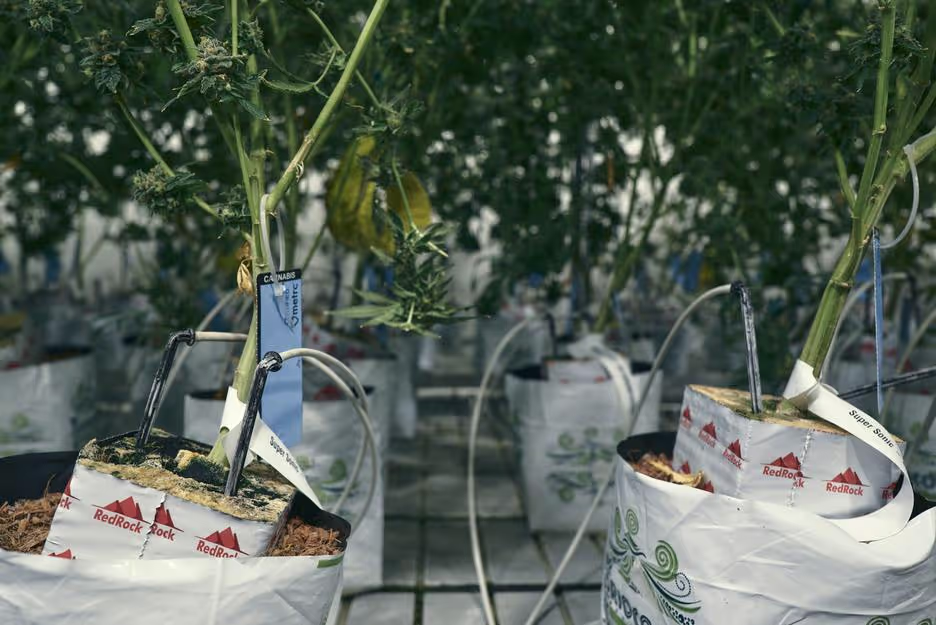Education Guide
Field capacity 101

We all know plants need water to grow and survive. But in the world of commercial cannabis cultivation, intelligent water management can mean the difference between an average crop and a grow with yields that improve year after year.
This is especially true in an indoor or greenhouse facility, where humans must stand in for Mother Nature to create a nurturing environment for their plants to thrive. For cultivators on a mission to improve their yields using crop steering techniques, one major component of the job is adjusting irrigation in response to vegetative and generative cues. And that requires regularly monitoring water field capacity.
What is field capacity?
Field capacity is the point after an irrigation event (or shot) at which a grow medium can no longer hold any more water. Once a substrate has achieved maximum water holding capacity, adding more water will cause it to seep as leachate (or runoff) from the bottom of the container. Typically measured as a percentage, field capacity lets the cultivator know how much water plants need to ensure optimal growth and nutrition.
It’s not unusual for growers to conflate field capacity with saturation and volumetric water content (VWC), both of which are related to irrigation, but they aren’t the same. Saturation occurs when water completely fills the spaces between the soil particles. Optimal field capacity, on the other hand, is achieved when the spaces between the soil particles contain both air and water. And while the field capacity refers to the amount of water in the substrate prior to runoff, VWC speaks to the amount of water a substrate is holding relative to its total volume. When the VWC in the soil is too low, the plant’s roots are unable to take up water.
How does field capacity factor into crop steering?
Crop steering is a plant growth management practice that manipulates light, climate, and irrigation in an indoor or greenhouse environment to encourage plants to grow a certain way.
Knowing how much water a grow medium can take before runoff happens is crucial when crop steering, because the process requires specific irrigation tactics to get the plant in a state of water stress during key moments of its growth cycle.
When a plant is producing leaves, stalks, and shoots in its vegetative stage, water needs to be as easily absorbed as possible – and it takes high irrigation frequency to get the job done. Once a plant reaches its generative stage and is preparing to flower, however, targeted stressors must be used to keep the focus on reproduction. Low irrigation frequency makes this possible, and unless cultivators take the time to test field capacity, figuring out the size and frequency of each shot becomes a guessing game.
Field capacity is a metric that growers need to reference time and time again through the different phases of plant growth, which is why it’s important that it be measured and recorded accurately from the start.

How to test field capacity
Natural variations in the substrate may alarm growers who are unprepared or don’t understand it. Not only does field capacity vary between different substrates, but variations can also occur between brands as well as batches.
Rockwool, for example, tends to maintain a consistent field capacity from substrate to substrate, with some variation likely between vendors. Coco, on the other hand, is minimally processed and blended from natural ingredients – typically coconut husks, pith, and chips – leading to variations in weight, packaging, and other specifications and making it difficult to achieve uniformity when hydrating. Cultivators who use perlite mix or their own substrate blend will experience higher variances, since these are the least standardized of all.
To be sure they have the most accurate measurements and are able to account for any variations, it’s important for growers to test the field capacity. In fact, getting in the habit of testing field capacity anytime there’s a significant change – e.g., when setting up a new grow, bringing in a new substrate, or hiring new members of the grow team – goes a long way toward setting up your cultivators for success.
Using a sensor like the TEROS 12 is the best, most reliable way for growers to not only test field capacity but also monitor what’s going on with their grow media at all times. The more growers stay informed about the water content and electrical conductivity (EC) in their substrates, the better equipped they’ll be to respond to the generative and vegetative cues that lead to bigger buds and better yields with every harvest.
Here’s how to test field capacity using a substrate sensor like the TEROS 12.
Materials needed for testing:
- Pre-dehydrated medium (e.g., a 2.2-gallon Dutch Plantin coco bag). If using soil, bake in an oven to dehydrate
- Scale
- Measuring cup
- Tote or container to hydrate the substrate
- Substrate sensor (e.g., TEROS 12)
- Notepad and pen
Step-by-step instructions:
- Weigh the pre-dehydrated substrate. In this example, our substrate weighs 899 grams.
- Hydrate with the total volume of the substrate. In this example, a 2.2-gallon coco bag will need 2.2 gallons of water.
- After the substrate is fully hydrated, wait 20 to 60 minutes.
- Weigh the substrate and take note of the weight. In this example, our hydrated weight comes out to 4,729 grams.
- Subtract the dry weight from the hydrated weight. In this example: hydrated weight of 4,729 - dry weight of 899 = 3,830 grams (NOTE: 1ml = 1 gram).
Divide the difference from dry to wet by the total volume of the substrate. In this example: 2.2 gallons = total volume of 8,327 ml. Hydrated-dry weight (3,830 grams) divided by total volume (8327) = field capacity of 46%.
Greater insights in cultivation
There’s a throughline between intelligent water management and better yields. For growers who crop steer their plants, understanding water capacity enables them to respond to vegetative and generative cues – and their respective shot needs – consistently and reliably with every harvest.
We built the AROYA cannabis production platform by combining hardware and software to give cultivators greater insight into all aspects of their cultivation – including field capacity. By tracking and monitoring their grow at every stage, cultivators are better able to spot and respond to trends in real time.
For a deeper dive into field capacity, read Plant available water: How do I determine field capacity and permanent wilting point? by ADDIUM Inc.'s own Dr. Gaylon Campbell and our Instagram crash course featuring Ramsey Nubani.
References
Warrick, A. W., H. M. Van Es, R. R. Allmaras, Oscar Kempthorne, J. J. De Gruijter, S. R. Yates, O. Wendroth et al. "Methods of Soil Analysis: Part 4 Physical Methods, 5.4." (Article link)
